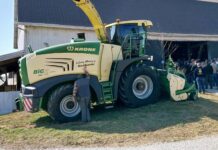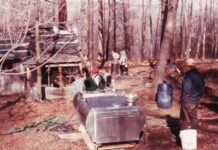In the wake of the corn husking bee, the farmer was left with exactly what he had wanted: a huge pile of husked ears of corn. Those ears, however, would do him little good so long as the kernels remained attached to the cob. Removing them would take a laborious process known as corn shelling.
Shelling

What’s that you say? There are no shells on corn! Yep, you’re absolutely right on that one. So why call it corn shelling? Well, that practice harks back to America’s earliest days when the Pilgrims were raising their first crops of corn and faced the dilemma of how to remove the corn kernels from the cobs. According to legend, the Indians in the region taught them an efficient way to accomplish this by scraping the cobs clean using the sharp edges of clam shells which were found in abundance along the Massachusetts shoreline. And ever since then the cleaning of corn kernels from the cob has been known as corn shelling.
However, the early settlers in the Ohio Country had no clam shells at their disposal, and thus had to be inventive when it came to the process of corn shelling. Several methods of accomplishing the job proved pervasive across the region. One of the most widely accepted was simply to use the blade of a shovel to scrape off the kernels. Another was to utilize the blade of an iron oven peel or an iron spatula for the purpose. In other instances, farmers took a butchering knife, embedded the blade in a block of wood, and used the dull edge of the knife to do the scraping, The job of corn shelling wasn’t done all at once like the husking was, but rather as the corn was needed on an almost daily basis.
Processing kernels
Once the kernels were separated from the cob, the work was only beginning. In order for them to be useful in making the wide range of puddings, porridges, breads, mushes, cakes and other dishes enjoyed by the pioneers, they first had to be processed. With commercial mills still unavailable to most, pounding the corn into meal was usually done with a large mortar made from a hollowed-out log or stone and a pestle shaped to the same opening. In some instances, logs about 3 feet long were hollowed out and used for the mortar. The pestle was a straight, heavy piece of wood equipped with a handle on each side and with a hole bored at the top to accept a piece of leather thong or chain. The pestle was tied around a springy tree branch or sapling, positioned so that it was suspended just above the mortar. Thus, the user was able to pull the pestle down so that it mashed the corn kernels into a rough meal, and the branch pulled it back up, saving the user some labor. This process was said to be very loud, and incidents are recorded in which it was mistaken by neighboring farmers for gunfire. Thinking Indian depredations were occurring, families either quickly fled the area or the men grabbed their rifles to aid the supposedly embattled family.
Once the kernels had been smashed by whatever means, the contents of the mortar were scooped out and put into a sifter or sieve so that unwanted dust, dirt and other material could fall out. Then the contents were dumped back into the mortar and the process was repeated. Indians used baskets with the splints closely woven together to achieve the same result. Stone querns could also be used to do the grinding, although these were few and far between on the frontier.
Indian influence
The Indian influence on the processing and preparation of corn for human consumption was pervasive across the Ohio Country with many corn dishes that are still enjoyed today retaining their original Indian names. These include pone, samp, hominy, suppawn and succotash (from the Indian word sohquttahhash).
Samp was corn that was pounded down into a coarsely ground powder. It was then boiled and eaten either hot or cold with milk or butter. To this day the wooden mortars used to crush the kernels for corn pone are still known as samp mortars and in some regions querns are referred to as samp mills.
Suppawn was corn meal that was combined with milk to create a thick porridge while pone was baked or fried in a pan to make a type of cornbread. Succotash was a dish in which corn was baked with lima beans. Hearty corn mushes and puddings were known as were corn dumplings or Jenny cakes (often known in the Ohio Country as Johnnycake). The pioneers also enjoyed parched corn which was cooked in the ashes of a fire and was very much like present-day popcorn.
A food that was favored by Indians and frontiersmen alike was nookick or nocake, which was carried in a long leather pouch for journeys. Made from Indian corn parched in hot ashes, it was described as sweet, toothsome and hearty. Nocake could be mixed with water or snow during the winter and it was said that three spoonfuls of nocake a day was one of the most nourishing meals known. It was said that on a diet of nocake alone Indians could carry heavy loads more fit for elephants than men.
Like everything else on the frontier, nothing ever went to waste. The stripped corn cobs were dried and used for fire kindling and were often enjoyed by children as toys, being used to build cob houses not unlike today’s Lincoln Logs, or as bodies for dolls. Corncobs often became the stoppers for pottery jugs, checkers on checkerboards or movers in other games, and kernels were also used as tokens in ballot boxes to determine the winners of elections. Yet another useful purpose for the cobs was achieved by making a hole in the wide end and inserting a stick or dowel. The result was a back scratcher that worked just dandy back then and just as well even today.














